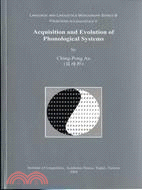| FindBook |
|
有 1 項符合
ching-pong au區靖邦的圖書 |
 |
$ 250 ~ 300 | Acquisition and Evolution of Phonological Systems
作者:CHING-PONG AU區靖邦 出版社:中央研究院-語言學研究所 出版日期:2008-10-01 規格:23*15.5cm / 100頁  共 2 筆 → 查價格、看圖書介紹 共 2 筆 → 查價格、看圖書介紹
|
|
|
- 圖書簡介
A dynamic computational model linking up human cognitive-develop¬mental properties (local mechanisms) and the transition patterns of sound changes (global phenomena) was built, in order to seek for possible solutions to resolve a number of controversial issues about the implementation of sound changes. In the simulation results of the model, two controversial sound change transition patterns, Neogrammarian regularity and lexical diffusion, can both be found under different conditions. During a shift without fusion of sounds, the pronunciation of the lexical items changes regularly as described in the Neogrammarian hypothesis; during a merger, the spoken forms display a regular pattern as in a shift at the beginning. Then the changing patterns become irregular lexically as described in lexical diffusion, when the two perceptual categories are fusing together. These conditions primarily match with the empirical data reported in literature. Besides the coexistence of these two controversial patterns, the simulation results also support the existence of another controversial phenomenon, the near-merger, in which individual speakers in a population cannot perceptually distinguish two sounds but can produce them differently. The present simulation provides a reasonable explanation for the coexistence of Neogrammarian regularity and lexical diffusion. To build such a model, it is necessary to replace a few assumptions in the traditional phonology. They include: (1) symmetry between perception and production; (2) irrelevance of phonetics; and (3) discreteness of boundaries. In the present model, perception and production develop individually in different cognitive subsystems at different times, so it is not necessary for perception and production to be the same. Secondly, instead of using abstract symbols to represent internal phonemes, the internal sounds are represented numerically in two continuous cognitive domains: a perceptual domain and an articulatory domain. Thus phonetic information can be retained internally in the two domains. Thirdly, no perceptual categories with infinitely sharp perceptual boundaries are assumed in the model. The formation of perceptual categories is driven by statistical distributions of sounds that infants listened to. This developmental process is simulated by a type of neural network, the self organizing map. As the population in the simulation does not have any contact with other populations and the cognitive subsystems of the agents are solely sounds and meanings, the lexical irregularity found in the change transition is definitely neither caused by borrowing from other populations nor by phonological, morphological or syntactic conditioning.
|










